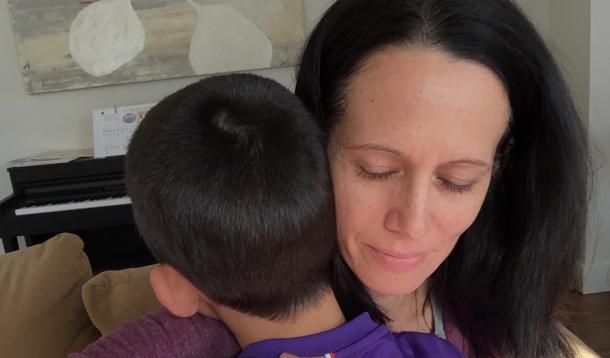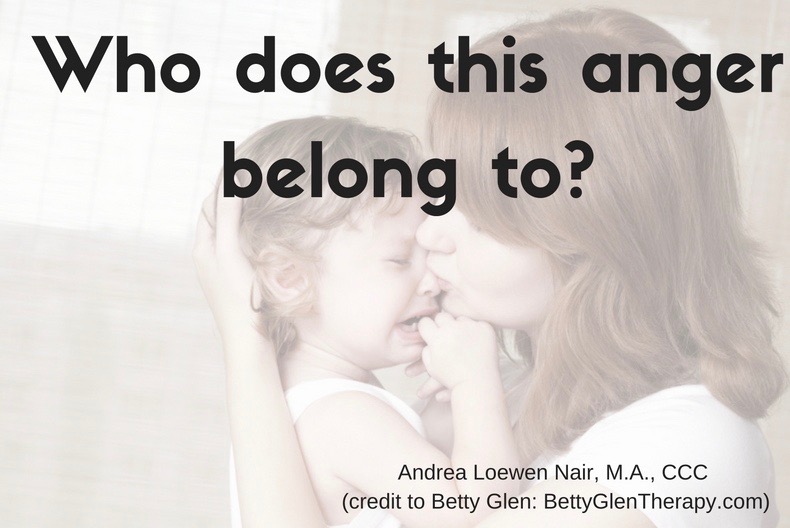
In all these years of studying and writing about tantrums, I admit I was still finding supporting my own children through their big emotions a challenge. I know the scripts, can do the calm-myself-down techniques, and even mostly exercise my own demons, but I was still sometimes flattened by other’s anger outbursts.
In conversations with my clients and the parents on my Facebook page, I know that I’m not alone in saying that a child-tantrum can be pretty defeating. Even when we feel confident in our approach to handling meltdowns, our self-talk can easily get the better of us and big emotions of our own get triggered.
In addition to those nasty messages like, “Are you kidding me – not again,” and “I’m so sick of this,” it just honestly takes a lot of energy to walk beside someone through their big feelings.
It’s only been since opening a school this September and being present for my students as they meltdown, too – every day – that I realized I needed to actually shift my mindset about another person’s upset. By the end of the day, I was limping home to spend the rest that day fighting to stay awake until bedtime.
Part of the way the flight-or-fight part of our brain works is that when someone around us gets activated, our first action is to also get activated. The switch that controls our instinctive reaction to defend or attack gets flipped on. It’s the second after that switch goes, which usually determines what behaviour we are going to do.
It takes energy to control our behavioural response and the physical ones, too: muscles get tensed, our heart rate increases, and breathing goes up. In a split second, we can go from calm to ready to pounce. It’s not surprising that it takes a great deal of control, skill, and practice to override that instinctual reaction.
Thankfully, it is possible to turn the emotional-activation switch off. I believe the first step to doing that is being aware of the anger and what it really represents.
I’ve learned to break down anger reactions – to distill them. I view the anger reaction as one burst with eight key parts:
1. The event that triggered the big emotions,
2. The messages our child is telling him or herself about the event/ his or her capabilities,
3. The instinctual, physical reaction our child experiences,
4. The release of that reaction (hitting/ shouting/ stomping away),
5. There’s also the bystander’s reaction, and
6. Any involvement in step 1 by another person
7. The calm down phase, and finally,
8. The solution-finding mode.
My response to anger now is to address each of these parts. For example, if a child gets very mad because another pushes him, I go through the steps like this:
1. Asking what happened the moment before the anger happened, and using validating language, a quiet voice, and head nods to show the child he is heard and trying to be understood. The words I often use are: “I wondered what happened here?”
2. Using positive core belief language to counter any negative ones that might have snuck in: “I see that you are mad because he pushed you. Maybe that happened by mistake? Or perhaps he was mad at you, too, and should have talked to you about that instead of pushing you? Let’s find out what’s really going on.”
3. Offering hugs or putting my arm around his shoulder to help sooth the physical response.
4. Reminding the child of boundaries for his behaviour: “It’s okay that you are mad, but it is not okay to hurt anyone with that anger. Let’s talk or walk that ‘mad’ out.”
5. Reeling myself in. This is a HUGE part of the steps for me. A friend of mine asked me this question, which is now one of the most critical reminders I need to be able to support someone else through upset without getting dragged into it.
Who does this anger belong to?

Most of the time the answer to that with my children, my students, and other important people around me is this: not me.
Pausing to remind myself that this anger does not belong to me allows me to do a kind of reset and stay focused on my child. I actually picture their angry words, facial expressions or aggression as images or words that fly around me without going into me. It’s amazing how helpful this imagery is!
Doing this helps me to allow another his or her process of having feelings without activating my own in the process.
6. Talking to the other person about the event and clarifying if there was a mistake, an apology that needs to be offered, or boundaries that need to be put in place.
7. Giving everyone time and space to process their big feelings. I usually go pretty quiet and stop talking to create that space.
8. Asking all those involved what can be done to address what has just happened and what can be done in the future to prevent the same thing from happening again (if that’s possible).
Your process of addressing and supporting anger doesn’t need to be exactly like mine, but it’s very helpful to identify and try a process that will suit you. As you use that process each day, evaluate if it’s helping you and if there might be changes to improve it. I’d love to hear about what you’ve learned about supporting your child’s anger. Feel free to comment here or over on my Facebook page.

The topic of money is often in the news, but the recent American presidential election has increased the visibility of headlines like: “Is America Divided in to ‘Haves’ and ‘Have-nots’?” Assuming your family is similar to mine, you have likely heard questions like this from the children in your house: “Mom, what’s a ‘Have-not’ – are we poor?”
I used to shudder at these kinds of issues, feeling uncomfortable about talking about money with my children. It was the norm in our parents' generation to be hush-hush about money, so myself, like many adults today, are often ill-equipped to answer the many money questions our curious kids have. Thankfully, teaching our children about money doesn’t have to be a painful process. To me, teaching children about money is similar to how we’d teach them any other value: with consistent, positive language, and an open mindset.
Just like most things in life, I view the approach with money as a relationship. As Ron Lieber, The New York Times money columnist and author of The Opposite of Spoiled says: “A ton of feelings are tied up in the decisions we make about our money and the amount we earn and have at any given moment.” He’s so right! Big emotions like pride, joy, excitement and also doubt, shame, and embarrassment happen around money.
There are many feelings tied into how much we have or don’t have, so we can’t really teach our children about money without addressing those emotions. This is why I consider it to be a relationship. If this connection is a positive one, it's easier for our children to have an open mindset, restraint, and critically examine if what they are about to spend their money on is in their best interest.
It's so important for me to make talking about money with my children and the students in my school just a part of everyday life. Ultimately these chats aren’t just about cash, they're also about values: patience, generosity, perseverance, goal setting, and restraint.
Here are seven suggestions for using positive language when speaking to your children about money:
Your child’s first financial teacher is YOU. Weave chats about money into your everyday language as early as you can. And don’t worry if you haven’t done that yet, there is still time to start with your older children. Make money chats as normal and casual as weather chats.
The more you talk about money now, the more confident your children will be with their financial future. TD has created several age-appropriate resources you can use:
It can be very tempting to blow off our children when they ask questions like, “Why don’t we go play on a beach in the winter like the Smith’s do?”
Responding with: “We can’t afford it,” doesn’t really teach our children anything. Actually, it teaches them to have a negative perspective that money is about being able to afford something or not, which isn’t true.
Within their age ability, answer their questions as best you can. I know that talking about money and social class is complex, so saying, “Amy Smith’s dad owns a big company so they have a lot more money than us,” may lead to more questions like: “Why don’t you have a big company? Why aren’t you getting more money?”
You are certainly welcome to try tackling those questions if your child will understand your words. If not, you could try something like this: “Amy’s parents are choosing to spend some of their money on a trip. We’re choosing to spend our travel money to visit grandma.”
As in the example above, steer away from these words:
Afford, can’t, none of your business, I deserve this
Use these open mindset words instead:
Choice, choose, budget, goals, solutions
For example, if your child is bugging you to go a vacation, you can use that as an opportunity to teach your child about setting budgets to achieve a goal. Perhaps try saying something like this: “If we want to go on a warm winter holiday, let’s look at how much that would cost, ways we can save that money, and how long it might take to save it.”
Children are intensely curious and very perceptive. They can see the headlines on the TV and over your shoulder when you're reading online. Be open to their questions by smiling and putting your focus on them when they ask.
Lieber had a great suggestion regarding questioning by children – ask them this: “Why do you ask?” I love this!
From The Reading Room:

Before we jump in and say too much, this simple query can make it clear what kind of information they really need so we can answer in a succinct, clear way. I’ve been caught a few times getting into an elaborate answer when really the child just wanted to know something simple like: Who puts money into the bank machine? It doesn’t just come out like magic?
There’s a great resource that can help you answer many questions, like “what’s a credit card” or “what’s a bank.” Click on this link to download a free, helpful activity book created by TD. You can print it off and go through it with your children. The book contains helpful child-related advice that will help make money matters an ongoing discussion in your home. Topics (such as debit cards, budgeting, saving, interest, and spending) are all presented in an entertainng and fun way that will keep your kids engaged.
Feeding an impulse can make us feel completely out of control—that we have to get the item we feel we can’t live without feeling. Demonstrating control over our ability to spend and deciding what is necessary is a great thing to show our children as early as possible.
I say things like this to my children: “Yes, I’d really like to have that jacket, but this one is just fine and it would be better to use that amount of money for yummy groceries.”
Doing this in other non-money-related contexts can also help children understand the difference between the two so when they’re considering a big-ticket item in the future, they’ll feel more equipped to decide.
For example, I really wanted to go to see a concert, but the only tickets left cost more than I was willing to pay. I spoke with my kids about really wanting to go, but not letting that steer me into making a bad decision. I wanted to go but I didn’t have to.
I’m a fan of involving banking advisors early on so children build a relationship with their bank and learn what kinds of financial systems are in place. Finding solutions and making big financial decisions can be quite complex, so talking about options are important. Take your children to the bank with you and open an account for them. TD has been putting resources into financial education, so check them out!
